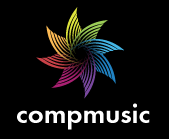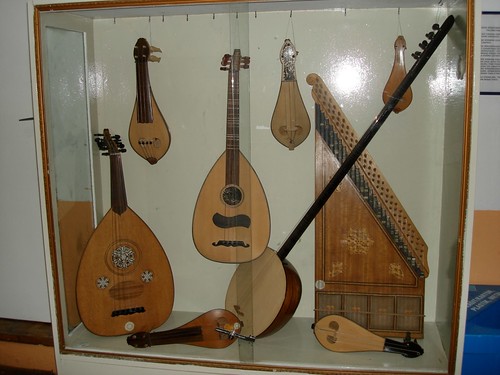Turkish instruments
Before my trip to Turkey (Istanbul and Izmir) on February-March 2011 I knew very little about Turkish music and its musical instruments. The trip was a discovery experience and here I write on what I learned about some of the traditional turkish instruments, like ud, cümbüş, ney, kanun, tanbur, yaylı tanbur, bağlama, kemençe, bendir, kudüm and darbuka. I was able to record some of them, recordings that I uploaded to freesound.org (turkish music) and I took some pictures that I uploaded to Flickr.com (turkish instruments).
First of all, it is important to make clear that Turkey is a very rich country in terms of musical traditions (Music of Turkey) and its musical instruments reflect that. For the context of the CompMusic project I was mainly interested in the instruments used in the Ottoman Music.
The ud (also spelled oud) is at the core of all middle eastern music and thus of all makam based music. In fact most of the pitch theories around the makams are explained using the ud. Despite regional differences, for example the turkish ud is a bit smaller than the arabic oud, the most distinguishable feature of the ouds compared with similar instruments like the European lute, is the lack of frets. This characteristic allows to play all the complex pitch scales and nuances of the makams. The Turkish ud has five double strings plus a single string at the low end. The five double strings are generally tuned as B2, E3, A3, D4, F#2 (or A2) and the low isolated string, called bam, is generally tuned as C#2 or D2. However the tuning is always a huge issue and there is very little agreement among turkish musicians and even less among musicologist, thus even the tuning of the open strings of the ud is an open discussion. The instrument is always played with a plastic plectrum and it is mainly used as a monophonic instrument. To get a closer look at the ud I had the opportunity to visit an ud maker from Izmir, M. Bülent Eryalman, and in Istanbul I recorded same ud samples (ud) at a friend's house. An interesting hybrid instrument of ud and banjo is the cümbüş, like the ud is fretles and like the banjo has a metal resonator and a skin body head. It has a metallic resonant tone (cümbüş1, cümbüş2).
The Turkish ney is very much used in Ottoman and Sufi music. It is an end-blown flute made of reed that has to be played in a oblique fashion in order to make it sound. It has a mouthpiece that creates a bowl-shaped cavity and that originally was made with water buffalo horn. It has six holes in the front and one in the back but in order to get the microtonal inflections of the makam music the players have to make extensive use of partial hole-covering. My first impression was that the ney was a simple instrument, but the visit to the ney shop of Ergin Karabulut and to the studio of the ney master Yavuz Akalin completely changed that impression. The construction of the instrument is quite sophisticated and the technique needed to produce the expressive sounds I recorded (ney1, ney2) is quite amazing. The modulations obtained by moving the head, the microtonal control by partial covering the holes, the control of the breathiness,... it is all really sophisticated. I have been practicing for some time on a cheap ney I bought at a music store near Taksim square in Istanbul and I have not yet been able to produce a single sound out of the instrument.
The Turkish kanun is like a zither but with twenty-six courses of strings and three strings per course. It is plucked with the fingernails or with two tortoise-shell picks, one in each hand. One of its most characteristic features is the latches (called mandals) that change the length of each course and with which the performer can obtain microtonal divisions (typically 6 parts per semitone). The performer actually changes the tuning of the strings during performance and that requires a lot of dexterity. I spent a whole morning in the studio of one of the best-known kanun players and scholars of Turkish music, Ruhi Ayangil. It was really an experience and I recorded some samples of him playing (kanun1, kanun2).
The tambur (or tanbur) is a long-necked, fretted, plucked lute. It has three double strings plus a low isolated one, generally tuned as A2, D2 (or E2), A2 and A1 for the single low string. It is played with a plectrum and only with the bottom A2 double string, the other strings are used as resonators. It is very curious that the soundboard has neither a sound hole nor braces, also the frets are movable and their number may vary. The sound (tambur) is not so loud but it has a very nice hollow and deep character. There has been some work on modelling the physics of the instrument (Erkurt and Välimäki, 2000) and synthesizing sounds from the obtained model (synthesis examples) and I also found an article studying the fret positions (Gedik et al., 2009). There is a variant of the instrument, the yaylı tanbur, that is played by bowing and thus results in a completely different sound (yaylı tanbur).
The bağlama (also referred as saz) is very much related to the tanbur but it is mainly used in folk music and in fact is the most common instrument in Turkey. I heard it on the streets quite a bit being used to accompany singing, like a guitar, and I recorded it on a music store being played by one of the shopkeepers (bağlama). I also recorded the greek bouzouki which is also quite used in Turkey and is similar to the bağlama (bouzouki).
The kemençe used in Turkish classical music is a small three string bowed instrument. I heard it in the Ottoman music concerts I went to but I did not have the opportunity to record it alone. One of the things that caught my attention was that the changing of the string length with the left hand is done by pressing sideways with the fingernails, instead of the most common way of pressing with the fingers downwards.
In terms of percussion instruments I learned something about three of the main ones used in turkish music: bendir, kudüm, and darbuka. The bendir is a frame drum used in Ottoman and Sufi music. I recorded a simple playing (bendir) but I heard some quite amazing performances using it. The kudüm is one of the most classic instruments and it consists of a pair of small tuned drums played with wooden sticks. I recorded some simple rhythms played on it (kudüm). Another instrument is the darbuka, a goblet shaped hand drum that is popular and very much used in folk music. I heard it being played in all kinds of music.
There are a lot of similarities between the Turkish instruments and the musical instruments of the other regions of the Middle East. All these instruments have been evolving within the characteristics of makam music, thus the need for flexible tuning and for expressive monophonic playing. So it is very interesting to see the connections between the musical instruments of a given musical culture and the characteristics of the music that is played with them.
I will definitely try to learn more about Turkish instrument on my next trip.
...xavier



